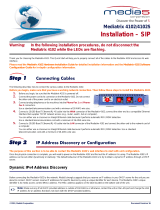
BCM50 to Mediatrix® Direct Gateway V1.0 June 2006
_______________________________________________________________________________________________________________________
3
External Distribution NORTEL
TABLE OF CONTENTS
1.
OVERVIEW: BCM50 TO MEDIATRIX ® ANALOG GATEWAY IN A DIRECT GATEWAY ENVIRONMENT
4
2.
BASE SCENARIO:.............................................................................................................................................................4
2.1
A
SSUMPTIONS
:..............................................................................................................................................................4
2.2
O
BJECTIVES
: .................................................................................................................................................................6
2.3
T
OPOLOGY
:...................................................................................................................................................................6
2.4
C
ONFIGURATION
S
TEPS
: ...............................................................................................................................................6
2.4.1
BCM50 Configuration .............................................................................................................................................6
2.4.1.1
Call Routing Configuration...............................................................................................................................................6
2.4.1.2
Destination Code Configuration .......................................................................................................................................7
2.4.1.3
PRI Route Configuration (External Trunk).......................................................................................................................8
2.4.1.4
Remote Access Package Definition ..................................................................................................................................9
2.4.1.5
Remote Access Package Line Assignment .....................................................................................................................10
2.4.1.6
H.323 Direct Configuration............................................................................................................................................12
2.4.1.7
Remote Gateway Definition............................................................................................................................................13
2.4.1.8
BCM50 Codec Definition...............................................................................................................................................14
2.4.2
Mediatrix® Configuration.....................................................................................................................................15
2.4.2.1
Mediatrix® IP Address Assignment...............................................................................................................................15
2.4.2.2
Mediatrix® GUI Install...................................................................................................................................................16
2.4.2.3
Device Discovery............................................................................................................................................................16
2.4.2.4
H.323 and Port Configuration.........................................................................................................................................17
2.4.2.5
Direct Gateway Configuration........................................................................................................................................18
2.4.2.6
Gateway CODEC Definition ..........................................................................................................................................19
2.4.2.7
Mediatrix® Configuration Transfer................................................................................................................................22
2.4.2.8
Packetization Time .........................................................................................................................................................23
2.4.2.9
Out of Band Signaling ....................................................................................................................................................27
2.4.2.10
Alias Type Restriction ....................................................................................................................................................28
2.4.2.11
Gateway Configuration Activation.................................................................................................................................29
2.5
V
ERIFICATION
:............................................................................................................................................................31
3.
SOFTWARE BASELINE:...............................................................................................................................................33
4.
REFERENCE DOCUMENTATION:.............................................................................................................................34






















